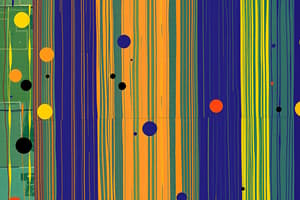Podcast
Questions and Answers
What is the purpose of choosing small, random values for the initial input weights in machine learning?
What is the purpose of choosing small, random values for the initial input weights in machine learning?
Which kind of bias in support vector machines focuses on maximizing the margin?
Which kind of bias in support vector machines focuses on maximizing the margin?
In k-nearest neighbors (KNN), which statement accurately describes the 'smoothness' preference bias?
In k-nearest neighbors (KNN), which statement accurately describes the 'smoothness' preference bias?
What effect does the curse of dimensionality have on the k-nearest neighbors algorithm?
What effect does the curse of dimensionality have on the k-nearest neighbors algorithm?
Signup and view all the answers
In the context of boosting, what does restriction bias refer to?
In the context of boosting, what does restriction bias refer to?
Signup and view all the answers
What is one of the key requirements for k-nearest neighbors (KNN) to model data accurately?
What is one of the key requirements for k-nearest neighbors (KNN) to model data accurately?
Signup and view all the answers
Which statement best summarizes the role of smaller weights in the training of machine learning models?
Which statement best summarizes the role of smaller weights in the training of machine learning models?
Signup and view all the answers
Which aspect of k-nearest neighbors could lead to ineffective modeling due to dimensionality issues?
Which aspect of k-nearest neighbors could lead to ineffective modeling due to dimensionality issues?
Signup and view all the answers
What does the restriction bias of a supervised learning algorithm refer to?
What does the restriction bias of a supervised learning algorithm refer to?
Signup and view all the answers
What is preference bias in the context of supervised learning algorithms?
What is preference bias in the context of supervised learning algorithms?
Signup and view all the answers
Which of the following is a characteristic of decision trees' preference bias?
Which of the following is a characteristic of decision trees' preference bias?
Signup and view all the answers
What is a consequence of neural networks not achieving much restriction bias?
What is a consequence of neural networks not achieving much restriction bias?
Signup and view all the answers
What is a method to address overfitting in neural networks?
What is a method to address overfitting in neural networks?
Signup and view all the answers
What is the main difference between the training rules for neural networks?
What is the main difference between the training rules for neural networks?
Signup and view all the answers
What is a general principle of Occam's Razor?
What is a general principle of Occam's Razor?
Signup and view all the answers
How many hidden layers are required to model arbitrary functions in neural networks?
How many hidden layers are required to model arbitrary functions in neural networks?
Signup and view all the answers
Study Notes
Biases in Supervised Learning Algorithms
-
Restriction Bias: The representational power of an algorithm, or the set of hypotheses an algorithm will consider, defining what a model can represent.
-
Preference Bias: The favored representations of a supervised learning algorithm, influencing its choice of hypotheses, e.g., preferring simpler representations.
Decision Trees
- Restriction Bias: Can model a set of hypotheses through tree structures.
- Preference Bias: Prefers shorter trees and trees with informative splits near the top (high information gain).
Artificial Neural Networks (ANN)
- Restriction Bias: Can model a wide range of functions with minimal restrictions, prone to overfitting.
- Preference Bias: Prefers low complexity: small weights, fewer hidden layers, and smaller hidden layers, achieved through:
- Small, random initial weights to avoid local minima and overfitting.
- Smaller weights to prevent overfitting.
Support Vector Machines (SVM)
- Restriction Bias: Depends on the chosen kernel, requiring a way to calculate instance similarity.
- Preference Bias: Seeks to maximize margin to avoid overfitting, using the Hyperplane Separation Theorem.
k-Nearest Neighbors (KNN)
- Restriction Bias: Nonparametric regression, can model any function with a distance metric.
- Preference Bias: Assumes:
- Locality: Near points are similar.
- Equality: All features matter equally.
- Smoothness: Nearby points have similar values.
- Limitation: Affected by the "Curse of Dimensionality", requiring more data with increasing features.
Boosting
- Restriction Bias: Same as the underlying weak learners.
- Preference Bias: Same as the underlying weak learners.
Studying That Suits You
Use AI to generate personalized quizzes and flashcards to suit your learning preferences.
Description
Explore the concepts of preference and restriction biases in supervised learning algorithms. This quiz will help you understand how these biases influence the representational power of algorithms and the hypotheses they consider. Perfect for organizing your thoughts for the CS7641 midterm.




